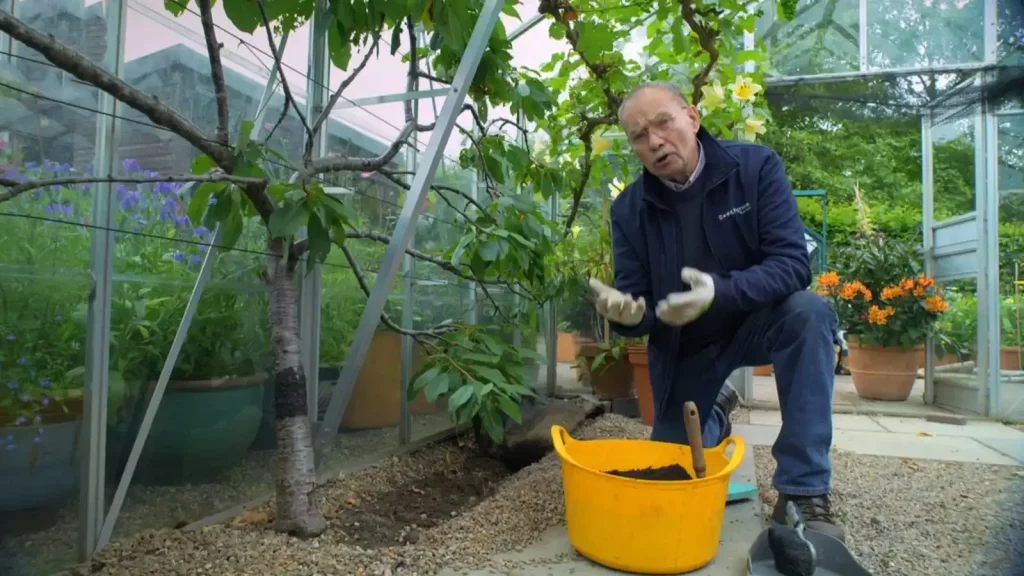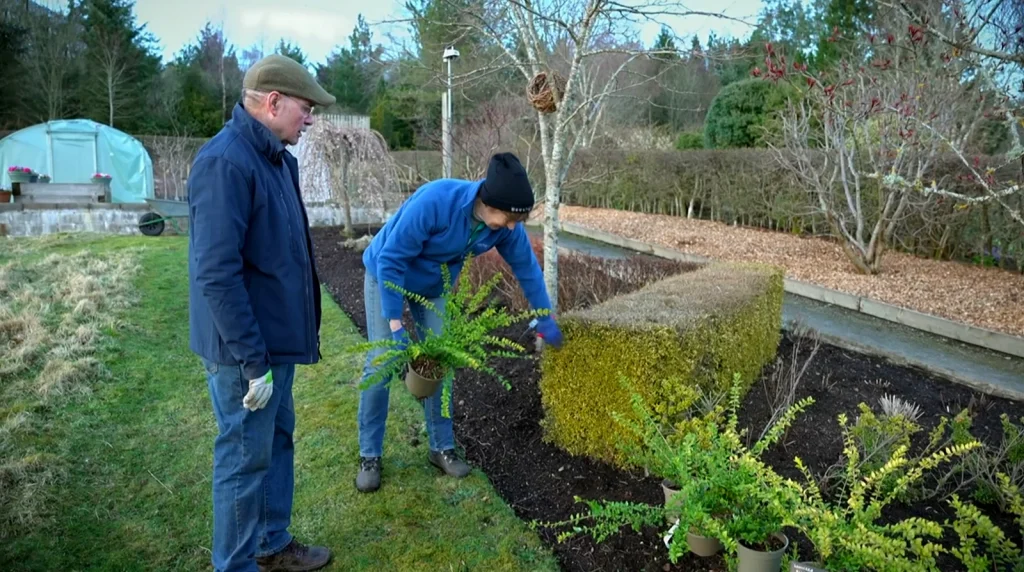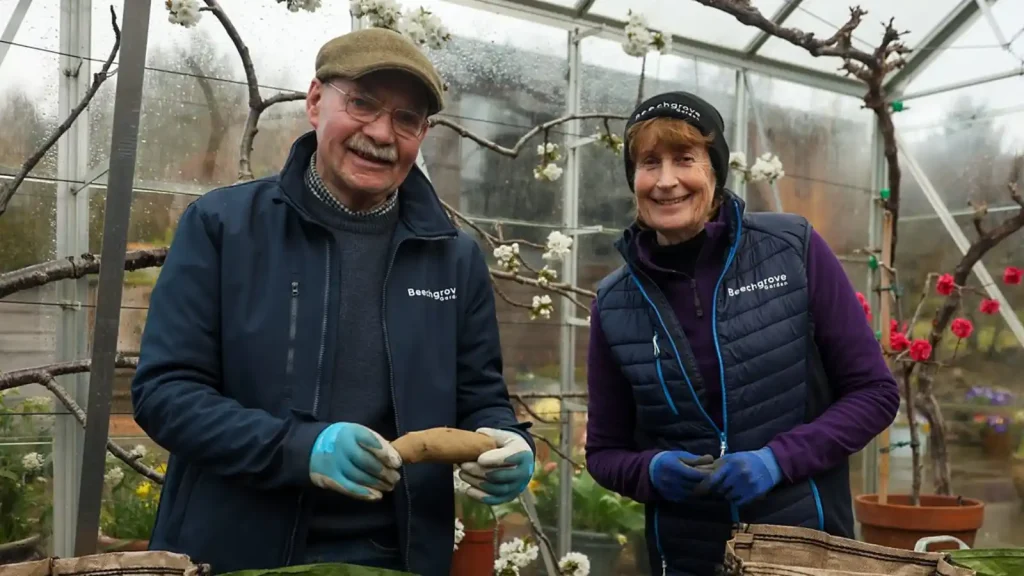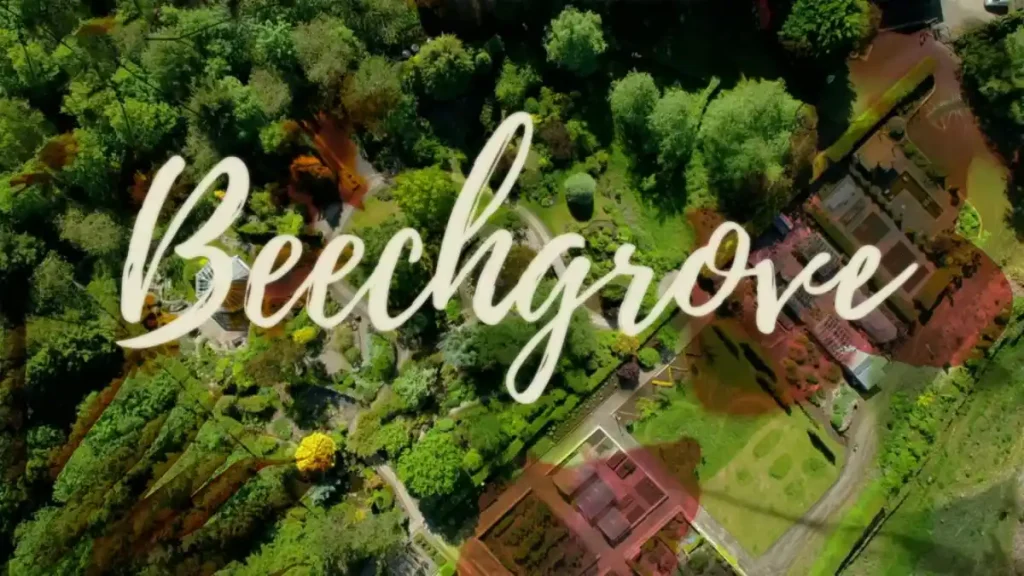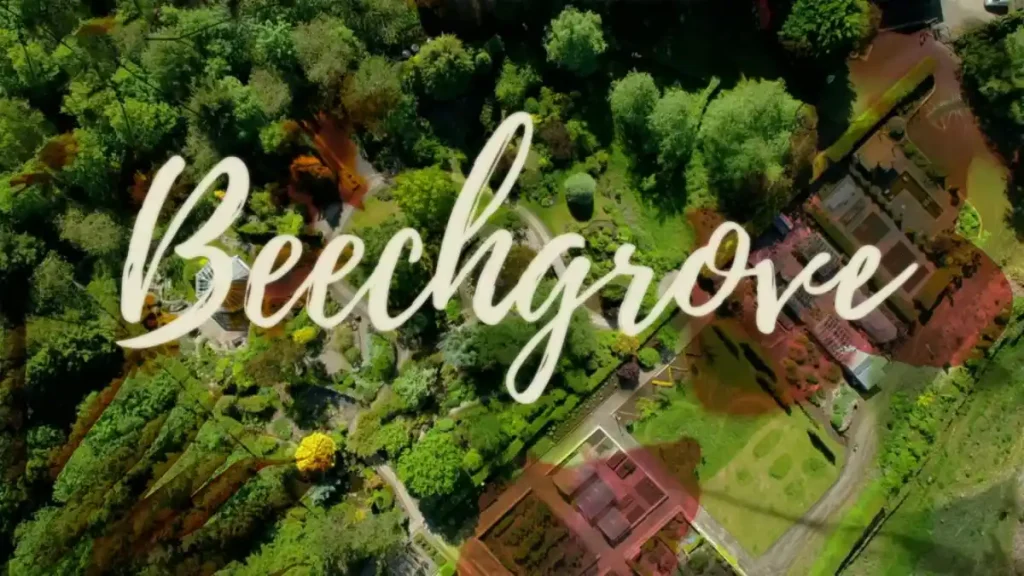The Beechgrove Garden 2024 episode 17: As the summer sun begins to shine brightly, it’s the perfect time to indulge in vibrant, refreshing fruit salads. This season, George Anderson and Lizzie Schofield are ready to cherry-pick the finest produce summer has to offer. However, the journey to this summer’s harvest has been anything but straightforward. A cold and wet spring transitioned into a rather cool start to the summer, raising questions about how these unusual weather patterns have impacted the year’s fruit and vegetable yield.
George Anderson is busy in the fruit cage, a dedicated space where he nurtures a variety of berries. This year, he focuses on pruning the loganberries and tayberries he carefully planted last year. These two berry varieties, known for their unique flavors and versatility in recipes, require meticulous care to ensure a bountiful harvest. As George tends to the fruit cage, he shares his expert techniques on pruning and caring for these delicate plants, offering viewers valuable insights into maintaining a healthy berry crop.
Meanwhile, Lizzie Schofield is out in the vegetable plot, examining the growth and quality of this season’s produce. Together, George and Lizzie take the opportunity to showcase the best of what has thrived so far, despite the challenging weather conditions. They explore the vegetable plot, pointing out the successes and setbacks, and provide tips on how to manage a garden under less-than-ideal weather patterns. Their hands-on approach and practical advice make gardening accessible to enthusiasts of all skill levels.
In addition to their garden tour, George and Lizzie delve into the importance of seasonal produce and how to make the most of what’s available. They discuss the nutritional benefits of various fruits and vegetables, emphasizing the importance of incorporating fresh, homegrown produce into everyday meals. With recipes and suggestions, they inspire viewers to get creative in the kitchen, turning their garden bounty into delicious and healthy dishes.
Adding to the excitement of this episode, Calum Clunie provides an update from his allotment in Leven. Known for his innovative gardening techniques and passion for sustainable practices, Calum shares the latest developments from his plot. He discusses the unique challenges he has faced this year and how he has adapted his gardening strategies to cope with the unpredictable weather. From pest control to maximizing yield, Calum’s segment is packed with practical advice and inspiring ideas for fellow allotment holders.
The Beechgrove Garden 2024 episode 17
As always, the episode is sprinkled with handy hints and expert tips, covering a wide range of gardening topics. Whether it’s advice on soil health, watering schedules, or pest management, George, Lizzie, and Calum ensure that viewers are equipped with the knowledge they need to succeed in their gardening endeavors. Their collective expertise and passion for gardening shine through, making each segment both informative and engaging.
“The Beechgrove Garden” has long been a beloved resource for gardeners across the country, offering a blend of practical guidance, inspiration, and a deep appreciation for the natural world. Episode 17 of the 2024 season continues this tradition, celebrating the joys and challenges of summer gardening. With its focus on seasonal produce, expert pruning techniques, and innovative allotment practices, this episode is a must-watch for anyone looking to enhance their gardening skills and enjoy the fruits of their labor.
Tune in to “The Beechgrove Garden” to join George Anderson, Lizzie Schofield, and Calum Clunie as they navigate the ups and downs of the gardening season. Whether you’re a seasoned gardener or just starting out, their expertise and enthusiasm will inspire you to dig in, get your hands dirty, and make the most of your garden. The journey from seed to harvest is a rewarding one, and with the right guidance, you too can enjoy a bountiful and beautiful garden this summer.
A Fruitful Adventure in Beechgrove Garden
Welcome to Beechgrove’s Fruit and Vegetable Paradise
Picture a lush, vibrant garden where the air is filled with the sweet scent of ripening fruit and the earthy aroma of fresh vegetables. This isn’t just any garden – it’s the renowned Beechgrove Garden, a horticultural haven that’s been inspiring green thumbs for decades. As you step into this verdant paradise, you’re instantly transported into a world where nature’s bounty is on full display.
The Beechgrove Garden isn’t just a feast for the eyes; it’s a treasure trove of gardening wisdom. Here, seasoned experts and novice gardeners alike come together to share their passion for growing. From towering fruit trees to humble vegetable patches, every corner of this garden tells a story of nurture, patience, and the joy of cultivation.
What’s Ripe and Ready in the Garden
As we wander through the garden, the abundance of ripe produce is almost overwhelming. Plump blackcurrants glisten like jewels in the sunlight, their deep purple hue a testament to their readiness. The air is filled with the tantalizing aroma of sun-warmed strawberries, their sweet fragrance inviting us to pluck them straight from the vine.
But the harvest isn’t limited to just fruits. The vegetable plots are a patchwork of colors and textures. Crisp lettuces form verdant rosettes, while vibrant tomatoes peek out from beneath their leafy canopies. In the brassica section, proud heads of cauliflower and broccoli stand tall, their intricate patterns a marvel of nature’s design.
Moreover, the garden is alive with the gentle hum of bees and the fluttering of butterflies, reminding us of the delicate ecosystem that supports this bountiful harvest. It’s a living, breathing example of how harmony in nature can lead to an abundance that nourishes both body and soul. As we explore further, we’ll uncover the secrets behind this thriving garden and learn how to bring a slice of this paradise into our own backyards.
Unveiling the Secrets of Successful Fruit Growing
Blackcurrant Varieties: From Baldwin to Big Ben
Stepping into the blackcurrant patch of Beechgrove Garden is like entering a treasure trove of flavor. The air is filled with the tangy aroma of ripe berries, each variety offering its own unique profile. From the classic Baldwin to the aptly named Big Ben, these little powerhouses of nutrition are a sight to behold.
Baldwin, with its rich history, stands proud at one end of the row. This old-timer has weathered many seasons, yet still produces berries with a depth of flavor that’s hard to beat. Next in line, we find Ben Connan, a more recent addition that’s quickly become a gardener’s favorite. Its large, juicy berries are perfect for everything from jams to summer puddings.
The Art of Pruning: Encouraging Young Growth in Blackcurrants
Pruning blackcurrants is like conducting an orchestra – every cut must be precise and purposeful. The goal? To create a symphony of new growth that will bear next year’s fruit. As we observe the pruned bushes, it’s clear that this is no haphazard task.
The key lies in encouraging as much young growth as possible. Just as a conductor coaxes the best performance from each musician, a skilled gardener nurtures each branch for optimal fruit production. By removing older, less productive wood, we redirect the plant’s energy towards vigorous new shoots. These young branches are the future of our blackcurrant harvest, promising plump, juicy berries in the seasons to come.
Loganberries and Tayberries: Mastering the Two-Year Fruiting Cycle
Moving on to the loganberry and tayberry patch, we’re greeted by an impressive sight. These robust plants, with their long, arching canes, are a testament to the two-year fruiting cycle that defines their growth. It’s a dance of patience and anticipation, where this year’s growth becomes next year’s fruit.
The secret to success with these berries lies in understanding and working with their natural rhythm. In the first year, new canes grow vigorously, reaching for the sky. These are the promise of future harvests, and they’re treated with care and respect. Come the second year, these same canes burst into bloom, eventually bearing the delicious fruits we’ve been eagerly awaiting.
Cherry Tree Rejuvenation: Feeding for Future Harvests
Our journey through the fruit garden brings us to a venerable cherry tree, its branches heavy with the promise of sweet, juicy fruits. But even long-established trees need a little TLC to keep producing bountiful harvests year after year. The process of rejuvenating this cherry tree is like giving it a new lease on life.
The first step in this rejuvenation process is feeding. Just as we need a balanced diet to thrive, so too does our cherry tree. A carefully formulated mix of nutrients is applied to the soil around the tree’s base. This isn’t just any old fertilizer – it’s a custom blend designed to meet the specific needs of cherry trees. As the nutrients slowly seep into the soil, they’re taken up by the tree’s roots, fueling new growth and ensuring a bumper crop of cherries in the seasons to come.
Exploring the Potager Garden and Artichoke Delights
The Potager Garden: Blending Beauty with Edibility
Step into the potager garden, and you’ll find yourself in a world where beauty and practicality dance in perfect harmony. This isn’t your average vegetable patch; it’s a feast for the eyes as much as it is for the palate. Here, ornamental plants mingle with edibles, creating a tapestry of colors, textures, and flavors that will ignite your imagination.
Imagine vibrant chives standing tall next to delicate nasturtiums, their bright orange and yellow blossoms a stark contrast to the deep greens surrounding them. As you wander through the rows, you’ll spot the unusual tree spinach, its leaves a surprising source of nutrients. But the true stars of this edible landscape are the artichokes, their silvery-green leaves unfurling like works of art.
Artichokes: From Ornamental Plant to Culinary Delight
Artichokes are the chameleons of the garden world. At first glance, they might seem like purely ornamental plants, their thistle-like appearance adding a touch of architectural interest to any garden bed. However, these versatile plants offer so much more than just visual appeal.
As the artichokes mature, they transform from striking ornamentals into culinary treasures. The large, globe-shaped flower buds are a delicacy prized by chefs and home cooks alike. But timing is everything when it comes to harvesting these green gems. Wait too long, and the tight bud will unfurl into a stunning purple thistle, beloved by bees but past its prime for eating. It’s a delicate balance between ornamental beauty and gastronomic potential.
Harvesting and Preparing Artichokes: A Step-by-Step Guide
Harvesting artichokes is an art form in itself. As you approach the plant, look for buds that are tight and firm, about the size of a fist. Using a sharp knife, cut the stem about 2-3 inches below the bud. This is the moment when you’ll truly appreciate the dual nature of these plants – beautiful in the garden, delicious on the plate.
Once harvested, preparing artichokes might seem daunting, but it’s simpler than you might think. Start by trimming off the top third of the artichoke and peeling away the tough outer leaves. Next, use scissors to snip off the spiky tips of the remaining leaves. Finally, remove the fuzzy choke at the center, revealing the prized heart beneath. With each step, you’re unlocking layers of flavor and texture that make artichokes a true culinary adventure.
Artichoke Dip Recipe: A Tangy Garden-to-Table Treat
Now that you’ve mastered the art of harvesting and preparing artichokes, it’s time to transform them into a mouthwatering dish. Picture this: a creamy, tangy artichoke dip that captures the essence of your garden in every bite. It’s the perfect way to showcase your homegrown produce and impress your guests.
To create this garden-to-table delight, start by roasting your prepared artichokes until they’re tender and slightly caramelized. Then, blend them with cream cheese, a hint of garlic, and a squeeze of fresh lemon juice. The result? A dip that’s bursting with flavor, combining the earthiness of the artichokes with a zesty kick. Serve it with crusty bread or fresh vegetables, and watch as your guests’ eyes light up with each taste. It’s more than just a dip – it’s a celebration of your garden’s bounty.
Nurturing Your Garden for Abundant Harvests
Pruning Plum Trees: Timing and Techniques for Optimal Growth
As the midsummer sun warms the orchard, it’s time to turn our attention to the plum trees. These fruit-bearing beauties require a gentle yet decisive touch to ensure they reach their full potential. The art of pruning plum trees is a delicate balance of timing and technique, much like conducting a symphony of growth and fruit production.
Why midsummer, you might ask? Well, this is when the risk of silver leaf disease is at its lowest. By pruning now, we’re giving our plum trees the best chance to heal quickly and avoid this potentially devastating fungal infection. As we approach the tree, secateurs in hand, we’re not just cutting branches – we’re sculpting the future of our harvest.
The goal is to create a wine glass shape, opening up the center of the tree to allow light and air to penetrate. This isn’t just about aesthetics; it’s about creating the perfect environment for plums to thrive. We start by removing any dead, diseased, or crossing branches. Then, we focus on cutting back new growth by about a third, always cutting just above a bud to encourage healthy new shoots.
Thinning Fruit: Quality Over Quantity in Your Orchard
As we move through the orchard, we come across branches heavy with developing fruit. It’s a sight that might make any gardener proud, but sometimes less is more. Thinning fruit is a practice that might seem counterintuitive at first, but it’s essential for producing top-quality fruit.
Think of it as nature’s way of ensuring the survival of the fittest. By removing some of the developing fruit, we’re allowing the tree to focus its energy on fewer, but higher quality plums. It’s like choosing between having a handful of exquisite, juicy plums or a bucketful of mediocre ones. The choice, when put that way, becomes clear.
We gently remove excess fruit, aiming to leave about 5-8 cm between each plum. As we work, we’re not just thinning; we’re also inspecting each fruit for any signs of damage or disease. It’s a meticulous process, but one that will pay dividends come harvest time. Remember, it’s better to have 30 top-quality plums than 70 that are barely worth eating.
Brassica Care: Mulching and Feeding for Continuous Crops
Shifting our focus to the vegetable patch, we find ourselves among the sturdy brassicas. These leafy greens and their cruciferous cousins are the backbone of many a garden, providing a steady supply of nutritious vegetables throughout the season. But to keep these plants producing, they need a little TLC.
Mulching is our first line of defense in brassica care. A layer of organic mulch – grass clippings work wonderfully – serves multiple purposes. It suppresses weeds, reducing competition for nutrients and water. It also helps retain moisture in the soil, crucial for these thirsty plants. As an added bonus, as the mulch breaks down, it feeds the soil, creating a rich environment for our brassicas to thrive.
But mulching alone isn’t enough. Brassicas are heavy feeders, and to keep them producing, they need regular nourishment. After harvesting, we give them a boost with a liquid feed. This quick-acting fertilizer provides an immediate nutrient hit, encouraging the plants to produce more of those delicious side shoots. It’s like giving our brassicas a energy drink, spurring them on to greater heights of productivity.
4.4. Deadheading and Maintenance: Keeping Your Garden Beautiful and Productive
As we wander through the garden, our eyes are drawn to the vibrant blooms that add splashes of color among the edibles. These ornamental plants aren’t just pretty faces; they play a crucial role in attracting pollinators and creating a balanced ecosystem. To keep them looking their best and blooming prolifically, deadheading is key.
Deadheading is like giving your plants a fresh haircut. By removing spent blooms, we’re not just tidying up; we’re sending a signal to the plant to produce more flowers. It’s a simple task that can have a dramatic impact on the overall appearance and productivity of your garden. Take roses, for example. A quick snip of faded blooms can encourage a second flush of flowers, extending the show well into the season.
But maintenance goes beyond just deadheading. As we move through the garden, we’re constantly on the lookout for signs of trouble. Perhaps we spot a vigorous shoot growing from the base of a grafted rose. This isn’t a welcome addition; it’s the rootstock asserting itself and needs to be removed promptly. By staying vigilant and addressing issues as they arise, we’re ensuring our garden remains not just beautiful, but healthy and productive throughout the season.
Putting Knowledge into Practice
Seasonal To-Do List: Tasks to Tackle in Your Garden Now
As the seasons shift, so do the needs of your garden. It’s time to roll up your sleeves and dive into the rewarding work that will set your garden up for success. First on our list is soil preparation. Just as a chef needs a clean kitchen, your plants need a well-prepared bed to thrive in.
Start by clearing away any debris left from the previous season. Then, get your compost ready – it’s like a superfood smoothie for your soil. Work it into the earth, feeling the rich texture between your fingers. This simple act is laying the foundation for a bountiful harvest to come.
Next, turn your attention to your tools. A gardener is only as good as their implements, after all. Clean and sharpen your pruning shears, oil your spade, and ensure your watering can is free of leaks. With your arsenal prepared, you’re ready to tackle whatever the garden throws your way.
Harvesting Guide: When and How to Pick Your Fruits and Vegetables
The moment you’ve been waiting for has arrived – harvest time! But before you rush in with your basket, take a moment to observe. Harvesting is an art as much as a science, and timing is everything. For fruits like apples and pears, a gentle twist should be all it takes. If they resist, they’re not quite ready.
When it comes to vegetables, each has its own tell-tale signs of readiness. Tomatoes should be firm but yield slightly to pressure, their color a vibrant red (or whatever hue your variety boasts). Zucchinis are best picked young and tender, about 6-8 inches long. And those peas? When the pods are plump and green, it’s time to start shelling.
Remember, harvesting isn’t just about collecting food – it’s about nurturing your plants for continued production. Use clean, sharp tools to make clean cuts, reducing the risk of disease. And don’t forget to harvest regularly. The more you pick, the more your plants will produce. It’s nature’s way of encouraging abundance.
Preserving the Harvest: Ideas for Storing and Using Your Garden Bounty
As your kitchen counter overflows with the fruits of your labor, it’s time to think about preservation. After all, you’ve worked hard for this harvest – let’s make it last! Freezing is a quick and easy method for many fruits and vegetables. Blanch your green beans before freezing to maintain their color and texture. Berries can be frozen on a tray before being transferred to bags, preventing them from clumping together.
But why stop at freezing when there’s a world of preservation techniques to explore? Pickling is not just for cucumbers – try pickling green tomatoes or even nasturtium seeds for a peppery condiment. Jams and jellies are a delicious way to capture the essence of summer fruits. And don’t forget about drying – herbs hung in bunches not only preserve your harvest but add a rustic charm to your kitchen.
For those vegetables you can’t preserve, get creative in the kitchen. Zucchini overload? Time to perfect your zucchini bread recipe or experiment with zucchini noodles. Too many tomatoes? Slow-roast them with herbs for an intense flavor boost to winter stews and sauces. Remember, every bit of produce you save or use is a testament to your gardening skills and a step towards self-sufficiency.
Conclusion of The Beechgrove Garden 2024 episode 17: Embracing the Joys of Fruit and Vegetable Gardening
Reflecting on the Rewards of Home-Grown Produce
As we come to the end of our gardening journey, it’s time to pause and savor the fruits of our labor. There’s something truly magical about biting into a sun-warmed tomato you’ve nurtured from seed, or sharing a bowl of freshly picked berries with loved ones. These moments are the true rewards of fruit and vegetable gardening, far beyond the mere act of growing food.
Think back to the first time you planted a seed, the anticipation as you watched it sprout, and the pride you felt as it grew into a thriving plant. Each step of the journey has been a lesson in patience, perseverance, and the wonders of nature. You’ve learned to work with the rhythms of the seasons, to understand the unique needs of different plants, and to problem-solve when challenges arise. These skills extend far beyond the garden fence, enriching your life in unexpected ways.
Moreover, your garden has become a sanctuary, a place where you can disconnect from the hustle and bustle of daily life and reconnect with the earth. The simple act of tending to your plants can be a form of meditation, calming your mind and rejuvenating your spirit. And let’s not forget the physical benefits – all that digging, planting, and harvesting is excellent exercise!
Looking Ahead: Planning for Next Season’s Garden
As one growing season winds down, the excitement for the next begins to build. Now is the perfect time to reflect on your successes and challenges, using these insights to plan an even more bountiful garden for the coming year. Start by keeping a garden journal if you haven’t already. Note which varieties thrived in your particular climate and soil conditions, and which might need a different approach next time.
Consider crop rotation to maintain soil health and prevent pest build-up. Perhaps that spot where the tomatoes flourished this year would be perfect for beans next season. Or maybe you’re ready to try a new fruit variety – how about adding a dwarf apple tree to your edible landscape? The possibilities are endless, limited only by your imagination and the boundaries of your garden plot.
Don’t forget to dream big! Winter is the perfect time to pore over seed catalogs, sketching out new garden layouts, and imagining the tastes and scents of next year’s harvest. Maybe you’ll expand your herb garden, try your hand at growing exotic vegetables, or finally build that greenhouse you’ve been dreaming of. Whatever your plans, remember that each new season brings fresh opportunities for growth – both for your plants and for you as a gardener.
As you look ahead, hold onto the joy and wonder that drew you to gardening in the first place. Whether you’re a seasoned green thumb or just starting out, there’s always something new to learn, try, and taste in the world of fruit and vegetable gardening. So here’s to the seasons past and those yet to come – may your harvests be bountiful, your table full, and your gardening journey ever-rewarding.
F.A.Q. The Beechgrove Garden 2024 episode 17
Q.: What impact did the unusual weather patterns have on this year’s harvest in “The Beechgrove Garden 2024 Episode 17”?
A.: The cold and wet spring followed by a cool start to the summer posed significant challenges for this year’s harvest. These unusual weather patterns affected the growth and quality of the fruit and vegetable yield, making it a complex season for gardening.
Q.: What techniques does George Anderson use for pruning loganberries and tayberries?
A.: George Anderson focuses on meticulous pruning techniques for loganberries and tayberries to ensure a healthy and productive harvest. He removes older, less productive wood to encourage vigorous new shoots, which are essential for next year’s fruit production.
Q.: How do George Anderson and Lizzie Schofield address gardening under challenging weather conditions?
A.: George and Lizzie showcase practical strategies for managing a garden under less-than-ideal weather conditions. They emphasize the importance of careful observation, adaptive techniques, and proactive measures to maintain a productive garden despite adverse weather.
Q.: What is Calum Clunie’s approach to coping with unpredictable weather in his allotment?
A.: Calum Clunie shares his innovative gardening techniques and sustainable practices to cope with unpredictable weather. He discusses pest control, soil health, and adaptive strategies to maximize yield, demonstrating resilience and adaptability in gardening.
Q.: What are the nutritional benefits of incorporating seasonal produce into meals, as discussed in “The Beechgrove Garden 2024 Episode 17”?
A.: Incorporating seasonal produce into meals offers numerous nutritional benefits. Fresh, homegrown fruits and vegetables are rich in vitamins, minerals, and antioxidants. George and Lizzie highlight the importance of using garden-fresh produce to create healthy, delicious dishes, enhancing both flavor and nutrition.
